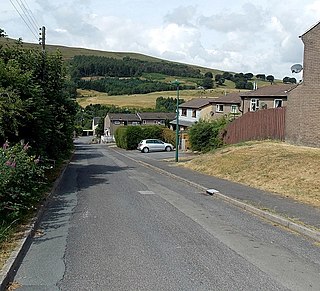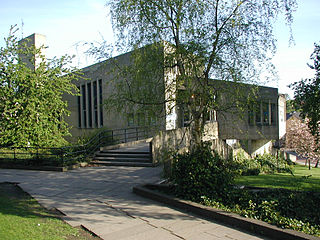
Blaenau Gwent is a county borough in the south-east of Wales. It borders the unitary authority areas of Monmouthshire and Torfaen to the east, Caerphilly to the west and Powys to the north. Its main towns are Abertillery, Brynmawr, Ebbw Vale and Tredegar. Its highest point is Coity Mountain at 1,896 feet (578 m).

Ebbw Vale is a town at the head of the valley formed by the Ebbw Fawr tributary of the Ebbw River in Wales. It is the largest town and the administrative centre of Blaenau Gwent county borough. The Ebbw Vale and Brynmawr conurbation has a population of roughly 33,000. It has direct access to the dualled A465 Heads of the Valleys trunk road and borders the Brecon Beacons National Park.

Monmouthshire is a county in the south east of Wales. It borders Powys to the north; the English counties of Herefordshire and Gloucestershire to the north and east; the Severn Estuary to the south, and Torfaen, Newport and Blaenau Gwent to the west. The largest town is Abergavenny, and the administrative centre is Usk.

Brynmawr is a market town, community and electoral ward in Blaenau Gwent, Wales. The town, sometimes cited as the highest town in Wales, is situated at 1,250 to 1,500 feet above sea level at the head of the South Wales Valleys. It grew with the development of the coal mining and iron industries in the early 19th century. Until the reorganisation of local authorities in 1974, Brynmawr was administered as part of the county of Brecknockshire.

Blaenau Gwent was a constituency in South Wales, that was represented in the House of Commons of the UK Parliament from 2010 to 2024 by Nick Smith of the Labour Party.
Brynmawr Furniture Makers Ltd was a furniture manufacturing company set up in the midst of the Great Depression in the United Kingdom as part of the Brynmawr Experiment in Brynmawr, Wales.

Blaenau Gwent County Borough Council is the governing body for Blaenau Gwent, one of the Principal Areas of Wales.

Blaina is a small town, situated deep within the South Wales Valleys between Brynmawr and Abertillery in the unitary authority of Blaenau Gwent, ancient parish of Aberystruth, preserved county of Gwent and historic county of Monmouthshire. The place name is derived from the Welsh word blaenau "uplands". As of 2011, the town has a population of 4,808.

The Twentieth Century Society, founded in 1979 as The Thirties Society, is a British charity that campaigns for the preservation of architectural heritage from 1914 onwards. It is formally recognised as one of the National Amenity Societies, and as such is a statutory consultee on alterations to listed buildings within its period of interest.

Aberystruth was an ancient ecclesiastical parish in Wales, located beside the north-west corner of the county of Monmouthshire against the border with Breconshire and between the parishes of Bedwellty and Trevethin. It extended from Beaufort in the north beyond Abertillery in the south.

In the United Kingdom, the term listed building refers to a building or other structure officially designated as being of special architectural, historical, or cultural significance; Grade I structures are those considered to be "buildings of exceptional interest". Listing was begun by a provision in the Town and Country Planning Act 1947. Once listed, strict limitations are imposed on the modifications allowed to a building's structure or fittings. In Wales, the authority for listing under the Planning Act 1990 rests with Cadw.

In the United Kingdom, the term listed building refers to a building or other structure officially designated as being of special architectural, historical, or cultural significance; Grade II* structures are those considered to be "particularly important buildings of more than special interest". Listing was begun by a provision in the Town and Country Planning Act 1947. Once listed, strict limitations are imposed on the modifications allowed to a building's structure or fittings. In Wales, the authority for listing under the Planning Act 1990 rests with Cadw.

Swffryd is a Welsh community on the boundary of Blaenau Gwent County Borough Council.

Waun-Lwyd or Waunlwyd is a village in the Ebbw Valley in Blaenau Gwent. It belongs in the community of Cwm.

Coalbrookvale is a village in the Ebbw Valley in Blaenau Gwent. It belongs in the community of Nantyglo and Blaina.

Sirhowy is a village in the Sirhowy Valley and the county of Blaenau Gwent.

The Architects' Co-Partnership (ACP) was a firm of English architects, founded in 1939 as the Architects' Cooperative Partnership by recent graduates of the Architectural Association School of Architecture. It encouraged teamwork, and set out to be a practice in which all members would be equal.

Blaenau Gwent is a county borough in the south-east of Wales. It borders the unitary authority areas of Monmouthshire and Torfaen to the east, Caerphilly to the west and Powys to the north. Its main towns are Abertillery, Brynmawr, Ebbw Vale and Tredegar. It covers an area of 109 km2 (42 sq mi) and in 2023 the population was approximately 66,993.

















